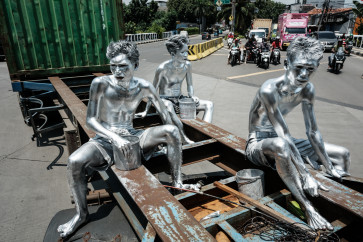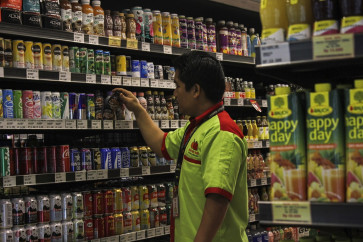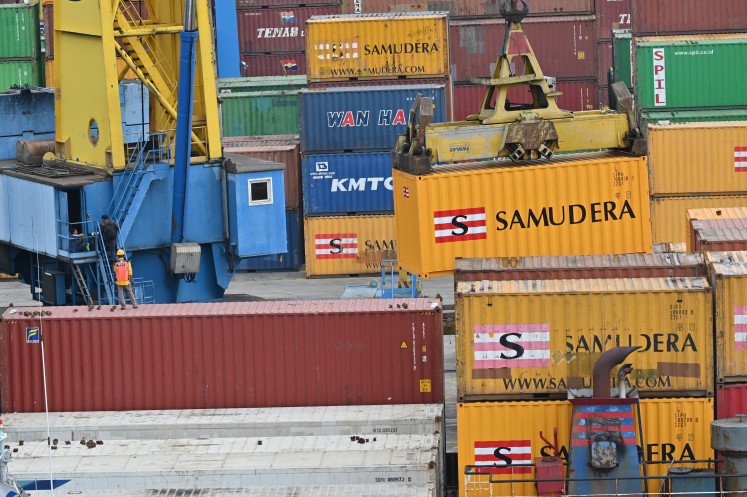Seeking open space to set kids free to play
Street soccer: An adult joins a group of children playing soccer in the street close to a railway station in Jakarta; there is no suitable open space nearby
Change text size
Gift Premium Articles
to Anyone
 Street soccer:: An adult joins a group of children playing soccer in the street close to a railway station in Jakarta; there is no suitable open space nearby. (JP/P.J.Leo) (JP/P.J.Leo)
Street soccer:: An adult joins a group of children playing soccer in the street close to a railway station in Jakarta; there is no suitable open space nearby. (JP/P.J.Leo) (JP/P.J.Leo)
Street soccer: An adult joins a group of children playing soccer in the street close to a railway station in Jakarta; there is no suitable open space nearby. (JP/P.J.Leo)
Children in heavily urban areas like Jakarta need open space to play.
It was a hot and sunny day, but a group of boys were cheerfully playing a soccer game in the street between houses in populated Jagakarsa, South Jakarta. They laughed and shouted.
Every once in a while, however, the boys had to stop their play to allow cars and motorcycles passing through the small street they played in.
Children playing street soccer is a common sight in the densely populated urban areas of rapidly thriving Jakarta where skyscrapers, office buildings, malls, apartments and hotels have mushroomed.
Local parents said the children resorted to playing soccer in the street, which is 'prone to danger', because they could not find an open space where they could play soccer.
Rina, mother of four-year-old Aleandra who lives in Jagakarsa, said the Jakarta government is aware of the lack of open space for children to play and therefore they have developed several public parks. But public parks can be found only in certain areas causing children living in an area that has no parks to play outdoors in small spaces in front of their houses or in the street.
'The parks that the Jakarta government have developed are too far to reach on foot,' she said.
As a consequence, she said, if her daughter wanted to play outside with her neighbors, she just let her play in front of their house.
'Luckily, there is a small space there, just big enough to play card games or play with computer tablets.'
That way, she can watch over her daughter playing while she is sitting in her warung (street side shop) in front of the house.
On weekends, she takes Aleandra on vacations 'to the zoo, swimming pool or mall,' said Rina.
Most affluent families in Jakarta have the same rituals. This explains why indoor playgrounds in malls are such a great business nowadays.
Tiara Prameswari, mother of two-year-old Danica, said she took her daughter to indoor playgrounds a lot. Usually on weekdays, since her job as a professional makeup artist doesn't require her to work during typical office hours.
She took Danica to popular city parks too. 'We went to Monas, Ayodya Park, Senopati Park and Tribeca Park in Central Park Mall. But we didn't feel comfortable because people are smoking freely, while I wanted to breathe fresh air,' she said.
The importance of playing
Living in a big city really came with a big price. Growing up in a small town, Tiara used to ride her bicycle or play hide and seek with her friends.
'I really want Danica to experience the same thing, but the situation is different now,' said Tiara. As a result of her and her husband's mobile job, her family has been living in an apartment in West Jakarta for two years now. 'Buying a house in the heart of the city is very expensive.'
Before moving to their apartment Tiara 'researched whether this apartment has a space where Danica can play or not. Here we have a swimming pool and a jogging track. But there's no special area for children to play.'
Do children really need a special area to play? Can a simple field be enough?
Child and family psychologist Anna Surti Ariani said there are three important conditions a playground should have.
'One, it should be childproof. What that means is that it should have fences or boundaries so children won't trip. The slide should be strong enough to support a child's weight and so on and so forth.'
'Number two, it should be fun. Not necessarily painted with cartoon characters, but the park should have various kinds of stimulation for the kids. Lots of color and a swing, aslide, a climbing area and other places to play are necessary,' Anna explained.
'Third, it should have a well shaded area where the children can rest.'
The Jakarta government, unfortunately, only allocated less than a fraction of the city's green area for parks.
Data retrieved from jakarta.go.id, DKI Jakarta Park and Cemetery Department claimed that this province has 2,719.33 hectares of open space green areas or 10 percent of the total city area but only 83.27 ha are dedicated to city parks.
'Are they all qualified as children's parks? They should be if the society helps to maintain the cleanliness,' said Anna.
But the most threatening part of urban life for children is not only the loss of playgrounds, which, according to her, is now replaced by many indoor playgrounds at malls.
'The real threat for children is the habit of not physically moving,' she claimed.
When a child is spending his day sitting down to play with his iPad, he is missing out the time that's normally spent strengthening the fundamental structure of his body.
'Physical activities are useful to build motor skills and coordination,' Anna said. 'Children need to build a strong foundation of fundamental skills in order to be able to perform more complex skills as they mature.'
The same physical activity can also be used to express negative energy that they often feel. 'When they are sad or angry, they can channel this negative energy through running or jumping, for example. This makes them emotionally healthier.'
And although doing physical activities indoor is better than not doing physical activities at all, Anna urged parents to let children play outside or in a non-air conditioned areas. 'Introduce them to Indonesia's tropical weather. Yes, I know, it's hot, and it will always be, that's why they need to feel it and adapt to it.'
The absence of parks and playgrounds will never eliminate the children's needs to play, to run around and jumping up and down. While the situation in the heavily urban areas isn't supportive of such activities, people are starting to do what they can to work their way around it.
'I know people who decided to make a green areas or small parks in their neighborhoods for their children to play, in their own housing area. This is society's problem. We don't have time to wait around for the government to solve it, do we?' (Astudestra Ajengrastri)









